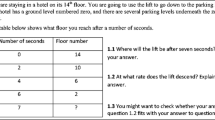Abstract
Rate is an important, but difficult, mathematical concept. Despite more than 20 years of research, especially with calculus students, difficulties are reported with this concept. This paper reports the results from analysis of data from 20 Australian Grade 10 students. Interviews targeted students’ conceptions of rate, focussing on the influence of representation and context on their expression of their understanding of rate. This analysis shows that different representations of functions provide varying levels of rate-related information for individual students. Understandings of rate in one representation or context are not necessarily transferred to another representation or context. Rate is an important, but commonly misunderstood, mathematical concept with many everyday applications (Swedosh, Dowsey, Caruso, Flynn, & Tynan, 2007). It is a complicated concept comprising many interwoven ideas such as the ratio of two numeric, measurable quantities but in a context where both quantities are changing. In mathematics classes, this is commonly expressed as change in the dependent variable resulting from a unit change in the independent variable, and variously described as constant or variable rate; average or instantaneous rate. In addition, rate may be seen as a purely abstract mathematical notion or embedded in the understanding of real-world applications. This paper explores the research question: Are students’ expressions of their conceptions of rate affected by either context or mathematical representation? This question was part of a larger study (Herbert, 2010) conducted with Grade 10 students from the Australian state of Victoria.
















Similar content being viewed by others
References
Adu-gyamfi, K. (2007). Connections among representations: the nature of students’ coordinations on a linear function task. Unpublished PhD, North Carolina State University. Accessed 30 January, 2010 from http://www.lib.ncsu.edu/theses/
Amit, M., & Fried, M. (2005). Multiple representations in 8th grade algebra lessons: Are learners really getting it? In H. Chick & J. Vincent (Eds.), Proceedings of the 29th Conference of the International Group for the Psychology of Mathematics Education (Vol. 2, pp. 57–63). Melbourne: PME.
Bowers, J., Nickerson, S., & Kenehen, G. (2002). Using technology to teach concepts of speed. In B. Litwiller & G. Bright (Eds.), Making sense of fractions, ratios, and proportions. 2002 Yearbook (pp. 176–187). Reston, VA: National Council of Teachers of Mathematics.
Bull, I., Howes, B., Kimber, K., Nolan, C., & Noonan, K. (2004). Maths for Vic 9. Melbourne, Australia: Pearson Education.
Carlson, M., Jacobs, S., Coe, E., Larsen, S., & Hsu, E. (2002). Applying covariational reasoning while modeling dynamic events: a framework and a study. Journal for Research in Mathematics Education, 33(5), 352–378.
Coe, E. (2007). Modeling teachers’ ways of thinking about rate of change. Unpublished PhD thesis, Arizona: State University. Accessed 29 January, 2010 from http://pat-thompson.net/PDFversions/Theses/2007Ted.pdf
delos Santos, A., & Thomas, M. (2005). The growth of schematic thinking about derivative. In P. Clarkson, A. Downton, D. Gronn, M. Horne, A. McDonough, R. Pierce, & A. Roche (Eds.), Building connections: research, theory and practice: Proceedings of the 28th Annual Conference of the Mathematics Education Group of Australasia (pp. 377–384). Melbourne: MERGA.
Goldin, G. A. (2008). Perspectives on representation in mathematical learning and problem solving. In L. D. English (Ed.), Handbook of international research in mathematics education (2nd ed., pp. 176–201). New York: Routledge.
Groves, S., & Doig, B. (2003). Shortest equals fastest: upper primary children’s pre-conceptions of speed. In J. Novotna (Ed.), Proceedings of the International Symposium Elementary Maths Teaching (pp. 79–82). Prague: Charles University.
Herbert, S. (2010). An investigation of middle secondary students’ mathematical conceptions of rate. Unpublished PhD, Ballarat: University of Ballarat.
Herbert, S., & Pierce, R. (2009). Revealing conceptions of rate of change. In R. Hunter, B. Bicknell, & T. Burgess (Eds.), Crossing divides: Proceedings of the 32nd annual conference of the Mathematics Education Research Group of Australasia (pp. 217–224). Palmerston North: MERGA.
Kaput, J. (1999). Teaching and learning a new algebra. In E. R. Fennema (Ed.), Mathematics classrooms that promote understanding (pp. 133–155). Mahwah, NJ: Lawrence Erlbaum Associates.
Kaput, J., & Schorr, R. (2002). Changing representational infrastructures changes most everything: The case of SimCalc, algebra & calculus. In K. Heid & G. Blume (Eds.), Research on the impact of technology on the teaching and learning of mathematics (pp. 47–75). Mahwah: Erlbaum.
Key Curriculum Press (2006). Geometres’ SketchPad.
Lamon, S. (1999). Teaching fractions and ratios for understanding: essential content knowledge and instructional strategies for teachers. London: Lawrence Erlbaum Assoc.
Lobato, J., & Thanheiser, E. (1999). Re-thinking slope from quantitative and phenomenological perspectives. Paper presented at the Conference of the International Group for the Psychology of Mathematics Education, Israel.
Mathematics Education Researchers Group (2004). SimCalc Projects. Accessed August 22, 2005, from http://www.simcalc.umassd.edu/
Orton, A. (1983). Students’ understanding of differentiation. Educational Studies in Mathematics, 14, 235–250.
Pape, S., & Tschoshanov, M. (2001). The role of representation (s) in developing mathematical understanding. Theory Into Practice, 40(2), 118–127.
Schorr, R. Y. (2003). Motion, speed, and other ideas that “should be put in books”. The Journal of Mathematical Behavior, 22(4), 465–477.
Seufert, T., Jänen, I., & Brünken, R. (2007). The impact of intrinsic cognitive load on the effectiveness of graphical help for coherence formation. Computers in Human Behavior, 23, 1055–1071.
Swedosh, P., Dowsey, J., Caruso, N., Flynn, P., & Tynan, D. (2007). Mathsworld: CAS active mathematical methods units 1 & 2. Melbourne: McMillan.
Ubuz, B. (2007). Interpreting a graph and constructing its derivative graph: stability and change in students’ conceptions. International Journal of Mathematics Education in Science and Technology, 38(5), 609–637.
Victorian Curriculum & Assessment Authority (VCAA) (2007). Victorian essential learning standards. Retrieved May 31, 2007, from http://vels.vcaa.vic.edu.au/essential/
Acknowledgement
An earlier version of this paper appeared in the conference proceedings of MERGA 2010: MERGA33 Fremantle.
Author information
Authors and Affiliations
Corresponding author
Rights and permissions
About this article
Cite this article
Herbert, S., Pierce, R. What is rate? Does context or representation matter?. Math Ed Res J 23, 455–477 (2011). https://doi.org/10.1007/s13394-011-0026-z
Received:
Revised:
Accepted:
Published:
Issue Date:
DOI: https://doi.org/10.1007/s13394-011-0026-z




